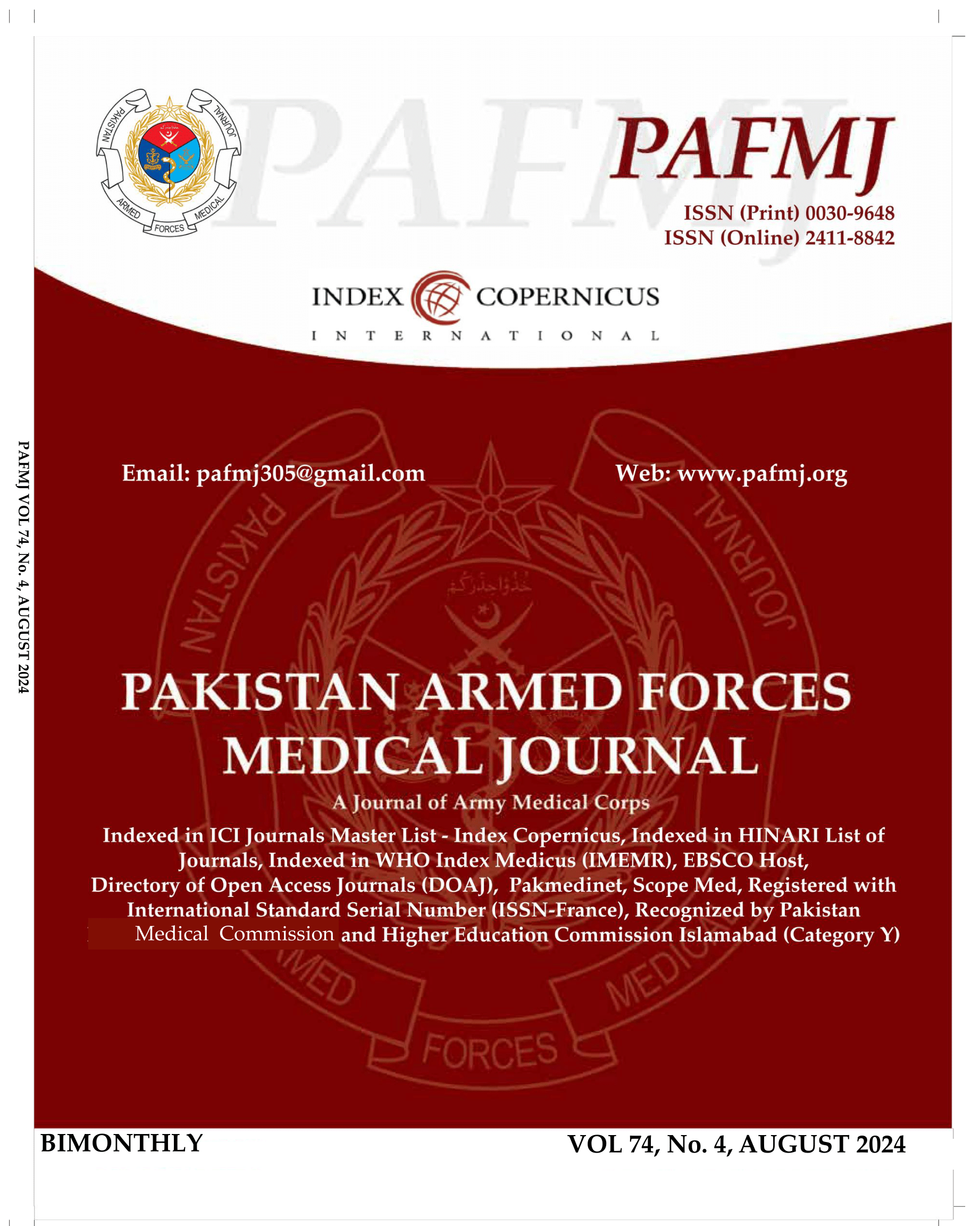Diagnostic Accuracy of Apex-Pulse Deficit for Detecting Atrial Fibrillation
DOI:
https://doi.org/10.51253/pafmj.v74i4.11531Keywords:
Apex-Pulse deficit, Ambulatory Electrocardiography, Atrial Fibrillation, Holter.Abstract
Objective: To evaluate the diagnostic accuracy of Apex-Pulse deficit for detecting Atrial Fibrillation in adult patients
Study Design: Cross sectional study
Place and Duration of Study: Department of Medicine, Combined Military Hospital, Peshawar Pakistan, Nov 2022 to Oct 2023
Methodology: One hundred and thirty-nine patients, aged 18 years or more, newly diagnosed with atrial fibrillation (A-fib) or a history of palpitations were evaluated independently by three separate groups of two examiners each for the presence of Apex-Pulse deficit. A-fib was later confirmed with ECG and Holter monitoring. Sensitivity and specificity were calculated for both diagnostic methods. Pearson correlation was calculated for correlation of the severity of Apex-Pulse deficit with the New York Heart Association (NYHA) Class of heart failure.
Results: The mean age of patients was 44.32±13.22 years with 66.2%(n=92) females and 33.8%(n=47) males. Patients had symptoms of the atrial fibrillation for a mean duration of 2.99±2.03 days. Apex-Pulse deficit was noticed in 75.5%(n=105) of the studied cohort. There was a linear relation between the NYHA Class and Apex-Pulse deficit severity with Pearson Correlation coefficient of 0.764 (p<0.001). The Apex-Pulse deficit method was able to detect atrial fibrillation in 78.4%(n=109) of the patients with a sensitivity of 96.33% and a specificity of 0% whereas ECG was able to detect the atrial fibrillation with a sensitivity and specificity of 100%.
Conclusion: The assessment of the Apex-Pulse deficit as a diagnostic tool for detecting Atrial Fibrillation has high sensitivity of 96%.
Downloads
References
Li J, Gao M, Zhang M, Liu D, Li Z, Du J, et al. Treatment of atrial fibrillation: a comprehensive review and practice guide. Cardiovasc J Afr 2020; 31(3): 45–50.
https://doi:10.5830/CVJA-2019-064
Hamad AK. New Technologies for Detection and Management of Atrial Fibrillation. J Saudi Heart Assoc 2021; 33(2): 169–176. https://doi.org/10.37616/2212-5043.1256
DeSouza IS. Emergency department cardioversion of acute atrial fibrillation. Lancet 2020; 396(10255): 885. https://doi:10.1016/S0140-6736(20)31315-5
Hindricks G, Potpara T, Dagres N, Arbelo E, Bax JJ, Blomström-Lundqvist C, et al. 2020 ESC Guidelines for the diagnosis and management of atrial fibrillation developed in collaboration with the European Association for Cardio-Thoracic Surgery (EACTS). Eur Heart J 2021; 42(5): 373–498.
https:// doi:10.1093/eurheartj/ehaa612
Rajkumar A, Bhattacharjee A, Selvaraj R. Diagnostic accuracy of apex-pulse deficit for detecting atrial fibrillation. Int J Adv Med Health Res 2019; 6(2): 52.
https://doi:10.4103/IJAMR.IJAMR_48_19
Faust O, Ciaccio EJ, Acharya UR. A Review of Atrial Fibrillation Detection Methods as a Service. Int J Environ Res Public Health 2020; 17(9): 3093. https://doi:10.3390/ijerph17093093
Karadavut S, Altintop I. Pulse deficit in atrial fibrillation — a different perspective on rhythm or rate control strategy. Kardiol Pol 2021; 79(11): 1231–1238. https://doi:10.33963/KP.a2021.0107
Muro T, Abe Y, Takemoto T, Inanami H, Nakai T, Okada Y. The clinical value of the apex beat as a marker of left atrial enlargement. J Cardiol 2021; 78(2): 136–141.
https://doi.org/10.1016/j.jjcc.2021.01.012
Pereira T, Tran N, Gadhoumi K, Pelter MM, Do DH, Lee RJ, et al. Photoplethysmography based atrial fibrillation detection: a review. NPJ Digit Med 2020; 3(1): 3.
https://doi.org/10.1038/s41746-019-0207-9
Lip GYH, Apostolakis S. Atrial fibrillation (acute onset). BMJ Clin Evid 2014; 2014: 0210.
Caraballo C, Desai NR, Mulder H, Alhanti B, Wilson FP, Fiuzat M, et al. Clinical Implications of the New York Heart Association Classification. J Am Heart Assoc 2019; 8(23): e014240. https://doi.org/10.1161/JAHA.119.014240
Fumagalli S, Said SAM, Laroche C, Gabbai D, Marchionni N, Boriani G, et al. Age-Related Differences in Presentation, Treatment, and Outcome of Patients With Atrial Fibrillation in Europe. JACC Clin Electrophysiol 2015; 1(4): 326–334.
https://doi.org/10.1016/j.jacep.2015.02.019
Ahmed I, Nasir A, Shams P, Shahab H, Hassan M, Subhani F, et al. Clinical characteristics and prognostic factors of atrial fibrillation at a tertiary center of Pakistan – From a South-Asian perspective – A cross-sectional study. Ann Med Surg 2022; 73. https://doi.org/10.1016/j.amsu.2021.103128
Dhungel S, Laudari S. Clinical Profile of Atrial Fibrillation in a Tertiary Hospital in Central Nepal. J Nepal Med Assoc 2017; 56(207): 335–340.
https://doi.org/10.31729/jnma.3276
Milman B, Burns BD. Atrial fibrillation: an approach to diagnosis and management in the emergency department. Emerg Med Pract 2021; 23(5): 1–28.
Kabutoya T, Takahashi S, Watanabe T, Imai Y, Uemoto K, Yasui N, et al. Diagnostic accuracy of an algorithm for detecting atrial fibrillation in a wrist‐type pulse wave monitor. J Clin Hypertens 2019; 21(9): 1393–1398.
https://doi.org/10.1111/jch.13648
Watanabe T, Tomitani N, Yasui N, Kabutoya T, Hoshide S, Kario K. Assessment of a new algorithm to detect atrial fibrillation in home blood pressure monitoring device among healthy adults and patients with atrial fibrillation. J Clin Hypertens 2021; 23(5): 1085–1088.
https://doi.org/10.1111/jch.14201
Yao RJR, Andrade JG, Deyell MW, Jackson H, McAlister FA, Hawkins NM. Sensitivity, specificity, positive and negative predictive values of identifying atrial fibrillation using administrative data: a systematic review and meta-analysis. Clin Epidemiol 2019; 11: 753–767.
Downloads
Published
Issue
Section
License
Copyright (c) 2024 Naveed Abbas, Hafiz Yasir Rehman, Faud Ahmed Siddique, Abid Sharif, Abdul Rehman, Fawad Ahmad

This work is licensed under a Creative Commons Attribution-NonCommercial 4.0 International License.















